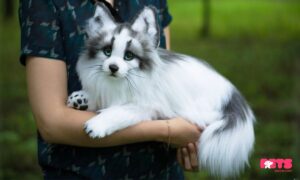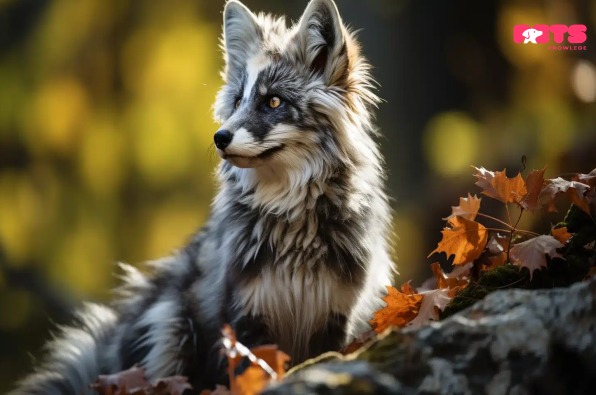The Canadian Marble Fox is a hybrid breed of fox that originated from specific interspecies rearing procedures. Occasionally, these foxes are referred to as the Arctic Marble Fox or just the Marble Fox. As the name recommends, it is ‘local’ to Canada, and the parent breeds are tracked down in the northern and western pieces of the country. It is a little crossbreed from the Red Fox and the Arctic Fox or Silver Fox. These foxes are distinguished by their remarkable look, which consists of white fur with dark patterns on the nose, ears, and claws.
They are likewise known for their capacity to make due in unforgiving environments, where temperatures can decrease to – 50°C. They have a thick layer of fur that assists with protecting their bodies against the cold, and they likewise have little ears and a short nose to assist with diminishing the intensity of misfortune. Being omnivores, these foxes derive their nourishment from a variety of sources, including mice, lemmings, birds as pets, and fruits.
Genetic Information And Origin:
Marble foxes are a novel and charming type of fox, known for their striking white and black fur. The starting points of the marble fox can be traced back to a hereditary change that took place in the frozen foxes’ captive reproduction programs in Canada.
Mutation In The Genes:
The hereditary transformation liable for the marble fox’s particular shading is a consequence of a latent quality that causes the high contrast color in their fur. This change was initially observed in Canada’s captive reproduction operations in the 1940s, and from then on, has turned into a famous breed in the fur trade industry.
Scientific Name:
There isn’t currently a different logical name for the marble fox. It is an individual of the sort Vulpes (the Latin word for fox, basically). This similar class includes the red fox, arctic fox, and fennec fox.
History Of Canadian Marble Fox:

If you need a Canadian marble fox as a pet, you probably want to know how they came to be. Interestingly, their name might suggest that they are a distinct kind of fox. Nonetheless, they are not an alternate animal category by any means. Its name alludes to where they are transcendently found and the shade of its fur.
Furthermore, the red fox (Vulpes vulpes), which is unique to Canada and Alaska, is the parent species of the Canadian Marble fox, not a naturally occurring species. The first Canadian Marble Foxes were raised in 1945 at Sverre Omber’s Farm in Norway, based on the National Fur Commission in the USA.
What Makes Them Unique?
It’s mostly because of their heavy, beautiful, and extremely rare fur. Second, they are extraordinarily intelligent creatures.
The marble fox’s symmetrical dark pattern around its nose and above its eyebrow is its most appreciated characteristic. Black lines edging the outer edges of the head are a unique feature on some marble foxes. The marble fox is bred to have different gray, black, and brown color combinations, much like marble. They are also distinguished by their enormous ears and unusually hairy, pointed nose.
Gorgeous Fur:

Canadian marble fox coats are, as its name indicates, symbolic of stone marble; they are primarily white with beautifully interwoven bronzed skin, and black, or gray stripes everywhere.
According to science, their coloring is the result of a genetic abnormality called “the hue of phase.” Usually, the highlight color flows around the face as it descends the back of the body. Many of them have the appearance of donning vintage burglar costumes.
Fascinating Canadian Marble Fox Secrets:
They’re most likely Norwegian
Marble foxes are not a distinct species; rather, they are vulpes, or red foxes, much like the ones you might find in the containers you’re using. Sometimes they may be raised especially for their coating, but as a metamorphosis, it may occur naturally. They’re specifically reared for their white and dappled coats, potentially with a melanistic assortment of red fox known as a silver fox, which has a hazier coat.
Although it’s difficult to say for sure, it seems that Norway is where the earliest records of marble foxes were made, as they were bred to be raised for their special fur.
- Not what it is
On the internet, this species is among the most inaccurately depicted. There are a lot of completely incorrect claims and very few trustworthy facts. These are a couple:
Notwithstanding their name, these are unrelated to and a distinct species from the Arctic fox, Vulpes lagopus.
The term “hybrid” is also frequently applied to it; however, this is inaccurate given either of its parents belongs to the same species.
Some sources alter the species designation midway through the post; some use images of dogs that are obviously of a certain breed; other people circulate an image of a plush toy on Facebook and call it a marble fox.
-
They’re Not The Best Pets!
Even if they’ve been controlled, they’re challenging. Yes, even zoos find it difficult to coexist with foxes. They require a tremendous deal of care and consideration, and because they will bond with people well, they may be very difficult to deal with. They are high-energy, loud, and smart little dogs. They are harming species that require specific habitats to be allowed to exist. They likewise smell. Fox pee and dung are probably the most un-fun things to have in your nursery, and carrying foxes into the house for any drawn-out period is a recipe in negative ways.
These Canadian marble foxes have not been reared for teachability, and keeping in mind that they might be more agreeable than their wild reciprocals, they are impervious to house preparation.
Residence Area And Territory:
Marble foxes are found in the northern regions of North America, which includes Canada and Alaska Country. They are regularly situated in tundra and boreal woodland natural surroundings. These foxes are very much adjusted to living in cool conditions, with thick fur and fur-covered paws to empower them to explore through snow.
Marble foxes are lone creatures, and each fox has its region. The size of the territory shifts depending upon the accessibility of prey and different assets. The territory could be larger in areas with lower prey thickness and more modest in regions with higher prey thickness.
Diet And Hunting:
Marble foxes are omnivores, and their eating routine comprises different prey, including little vertebrates, birds, and bugs. They are additionally known to search for food when fundamental.
These foxes are expert predators and locate prey by using their keen sense of smell. Additionally, they are quick runners, which helps them capture moving prey. They follow their prey while hunting and then leap to capture it.
The Canadian Marble Fox lives where?
This is not how foxes usually react. They are raised in an untruthful manner, and because their parent, the cold/silver fox, is mostly from icy areas in Northern Canada, they are called Canadian marbled foxes. There are reports of a portion of these foxes living currently living in the wild however most are reproduced and kept in bondage. There are lots of people and breeders in the USA and Canada that provide legal permits.
Can Canadian Marble Foxes Be Adopted As Pets? In The USA
A few states might permit the keeping of marble foxes. Be that as it may, foxes are classed as wild or fascinating pets and most states in the USA have an extensive cover prohibition on keeping these creatures as pets. Altogether, it is unlawful in 35 states of the USA to claim a fox as a pet, valid in only 15. In any event, you might need a grant or a permit to keep the animal as a pet in the places where it might be legal.
Scientific Classification Of Canadian Marble Fox:
| Kingdom | Animalia |
| Phylum | Chordata |
| Class | Mammalia |
| Order | Carnivora |
| Family | Canidae |
| Genius | Vulpes |
| Scientific name | Vulpes vulpes |
Breed Overview:
| Color | Brown, Black, White |
| Skin type | Fur |
| Height | 24 – 27 inches Male
18 – 20 inches Female |
| Length | 23 – 25 inches |
| Lifespan | Up to 15 years |
| Weight | Male 2.7 – 9.5 Kg
Female 1.4 – 3.6 Kg |
| Top speed | 30 mph |
| Habitat | Human captivity |
| Diet | Omnivores |
| Age of sexuality | 10 months |
| Location | Worldwide |
| Type | Mammal |
| Litter size | 1-13 kits |
| Biggest threat | Fur industry |
Conclusion:
In conclusion, marble foxes are surprising animals of the wild, adjusted to flourish in the cruel Arctic conditions of North America. Their unmistakable coat hue, hunting ability, and slippery person make them both enamoring and tricky. Even if human settlement and geographical loss represent threats to their population, continuous preservation efforts aim to ensure their continued survival in the natural world.
FAQ’s
Q: Is the Canadian marble fox carnivorous, omnivorous, and herbivorous?
Ans: Canadian marble fox is usually carnivorous but most of their diet consists of meat.
Q: What is marble fox?
Ans: The Canadian Marble Fox is a hybrid breed of fox that originated from specific interspecies rearing procedures. Occasionally, these foxes are referred to as the Arctic Marble Fox or just the Marble Fox.
Q: Do you have a marble fox as a pet?
Ans: Although marble foxes are frequently bred and sold as pets, not all governments or nations allow their possession.
Q: Are marble foxes red foxes?
Ans: Although marble foxes have not been identified as a distinct variety or color morph like silver particles or platinum foxes are, they actually evolved from red foxes.

